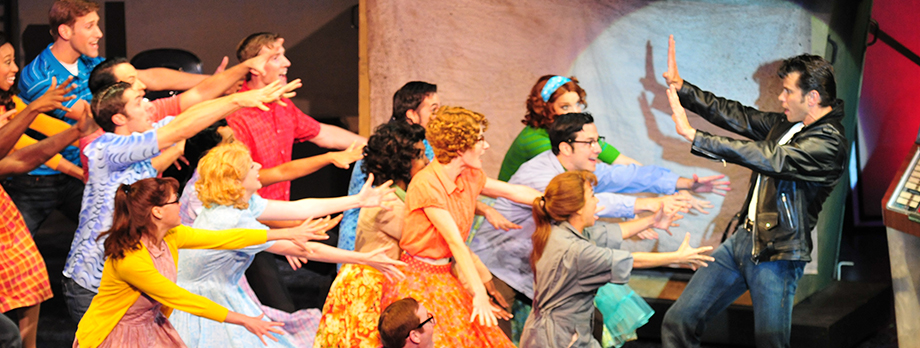ABOUT
1950s America Was All Shook Up
All Shook Up is based on Shakespeare’s Twelfth Night yet takes place in a mall Mid-western American town in the 1950s. 1950s’ America, like Shakespeare’s Elizabethan England, teetered on the brink of great change, a time when art, literature, politics and music were breaking new ground.
After the devastation of two World Wars and the grinding desperation of the Great Depression, artists were asking questions, raising doubts and finding new, provocative ways to express themselves. Older Americans longed for peace and quiet, but their children yearned for change and dreamed of a better life; the wars had been fought for freedom and they wanted that same freedom here in America, freedom to express themselves without repercussion.
The 1950s was the launching point for a Civil Rights movement that sought to change hundreds of years of hatred, prejudice, and segregation. On May 17, 1954 the Supreme Court ruled on segregated schools in Brown v. Board of Education: "Separate educational facilities are inherently unequal." This decision instantaneously broadened the concept of freedom, not just in the area of civil rights, but in all aspects of social behavior. Suddenly there were rebels on the screen, on the page and the sage. Authors known for their fresh and spontaneous style, the "Beats," emerged. Jack Kerouac’s, 1957 novel On the Road shocked mainstream America with its flowing stream-of-consciousness prose. Ironically, 1950s also brought “McCarthyism,” a term coined when Joseph McCarthy dominated Cold War politics with his “witch-hunts” and interrogations of Communist suspects within the U.S. government and throughout the arts world. The 50s were a time when ideas split the United States right down the middle. McCarthyism, segregation, equal opportunity, censorship, were all ideas that Americans had strongly conflicting views on.
Elvis Presley – Breaking the Barriers/Breaking the Mold
Elvis Aaron Presley was his own kind of rebel. He managed to fuse white country and black rhythm and blues musical styles, to form a style all his own; one that made him popular with both white and black audiences and redefined popular music. Elvis promoted a style, an outlook, an optimistic way of looking at the world that became the standard for cool during his time and beyond. Composer and conductor Leonard Bernstein called Presley “the greatest cultural force in the twentieth century…he changed everything – music, language, clothes, it’s a whole new social revolution.”
Elvis was born in Tupelo, Mississippi on January 8, 1935. As members of the Pentecostal Church, he and his family regularly listened to Gospel music, and when the family moved to Memphis, Tennessee, he was exposed to rhythm and blues. Growing up, Presley loved to hang out at all-night gospel shows and to sneak into black churches to hear the music, absorbing the mixture of black and white musical traditions that would become his trademark.
Presley made his first public appearance, where he began to show off his raucous and provocative style, wildly swiveling his hips to the music. Many music experts believe that Presley’s trademark hip-swaying was borrowed from the dances he saw in gospel churches. Scholars argue that gospel music was the first example in the United States of the integration between African and European music styles, stressing that gospel blurred the lines between the sacred and the secular. As rock and roll developed, it borrowed this idea, so that its best songs – and we certainly see this in All Shook Up – deal with primal emotions like joy, love and desire in an almost spiritual way.

